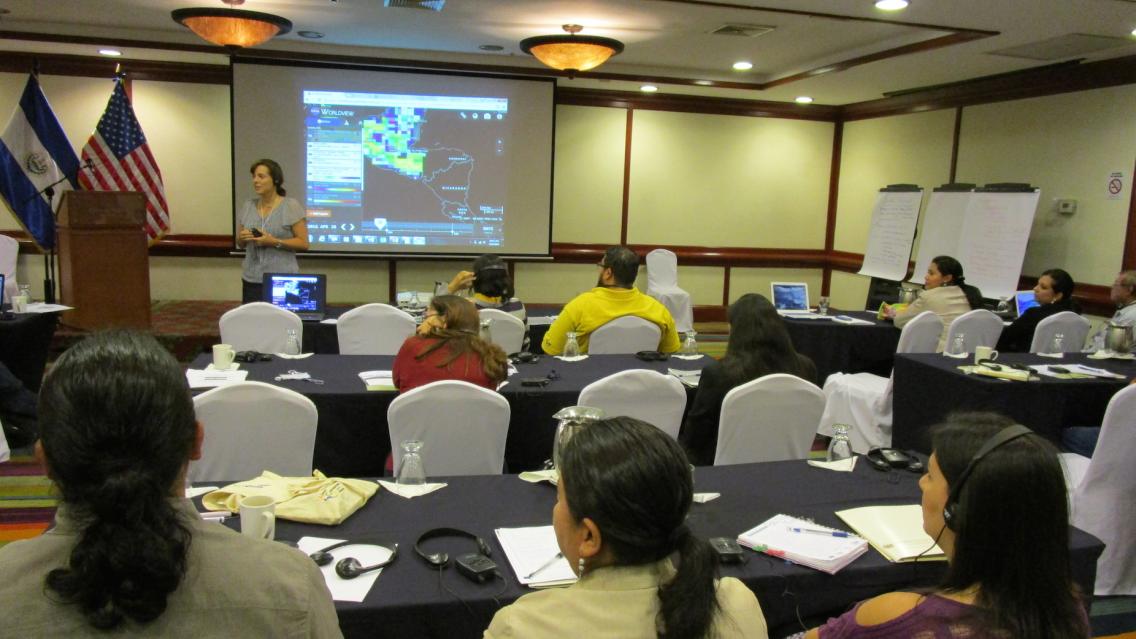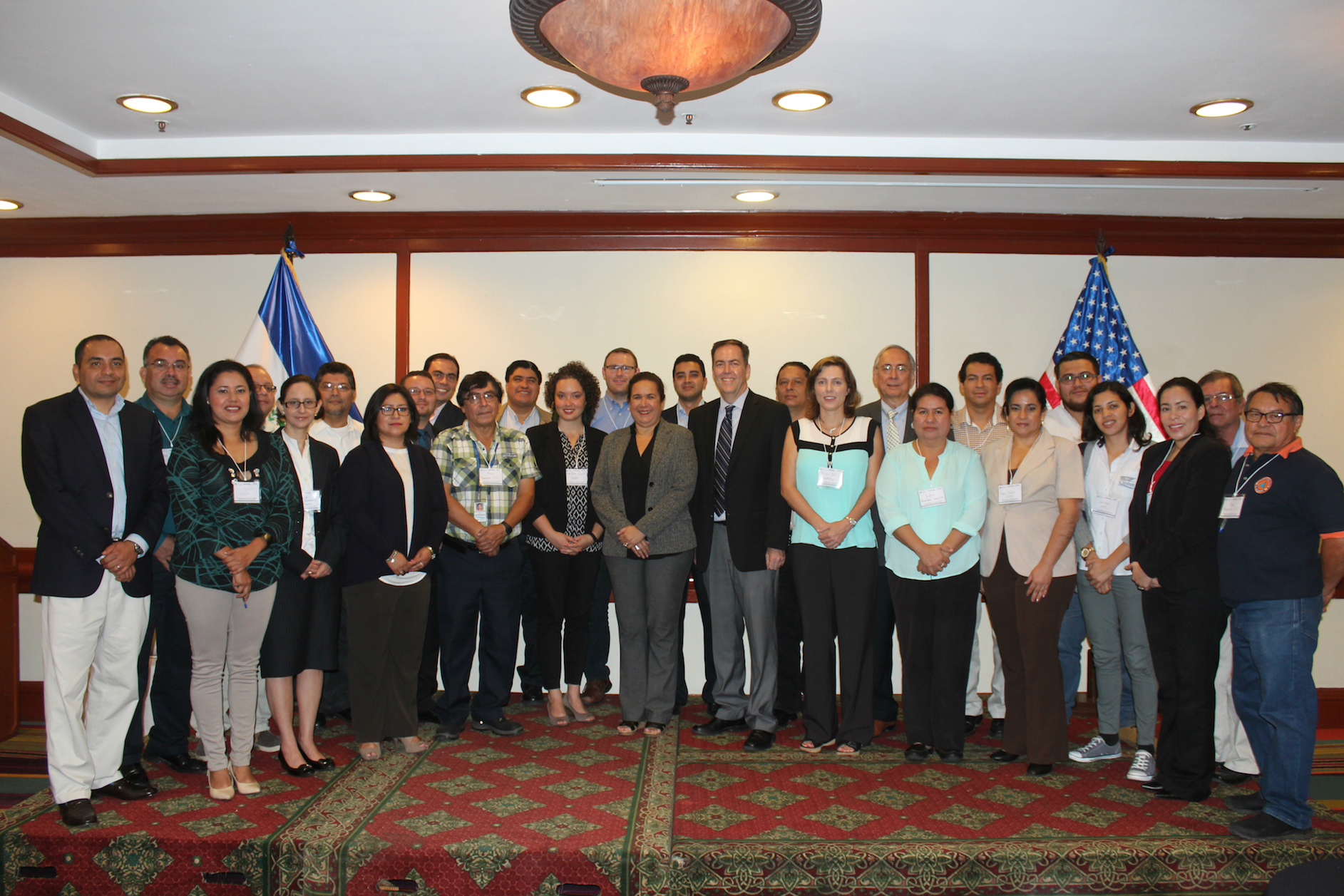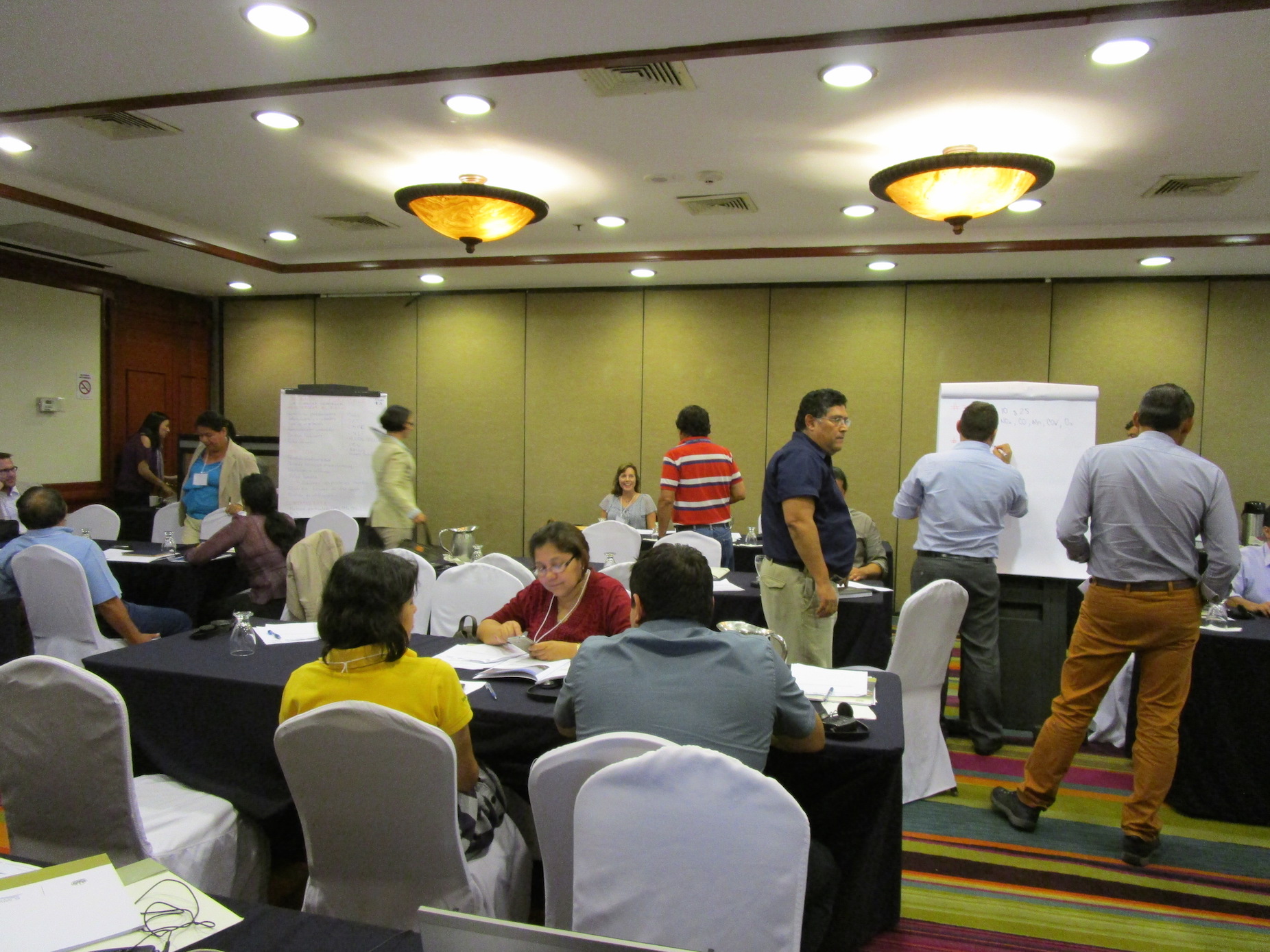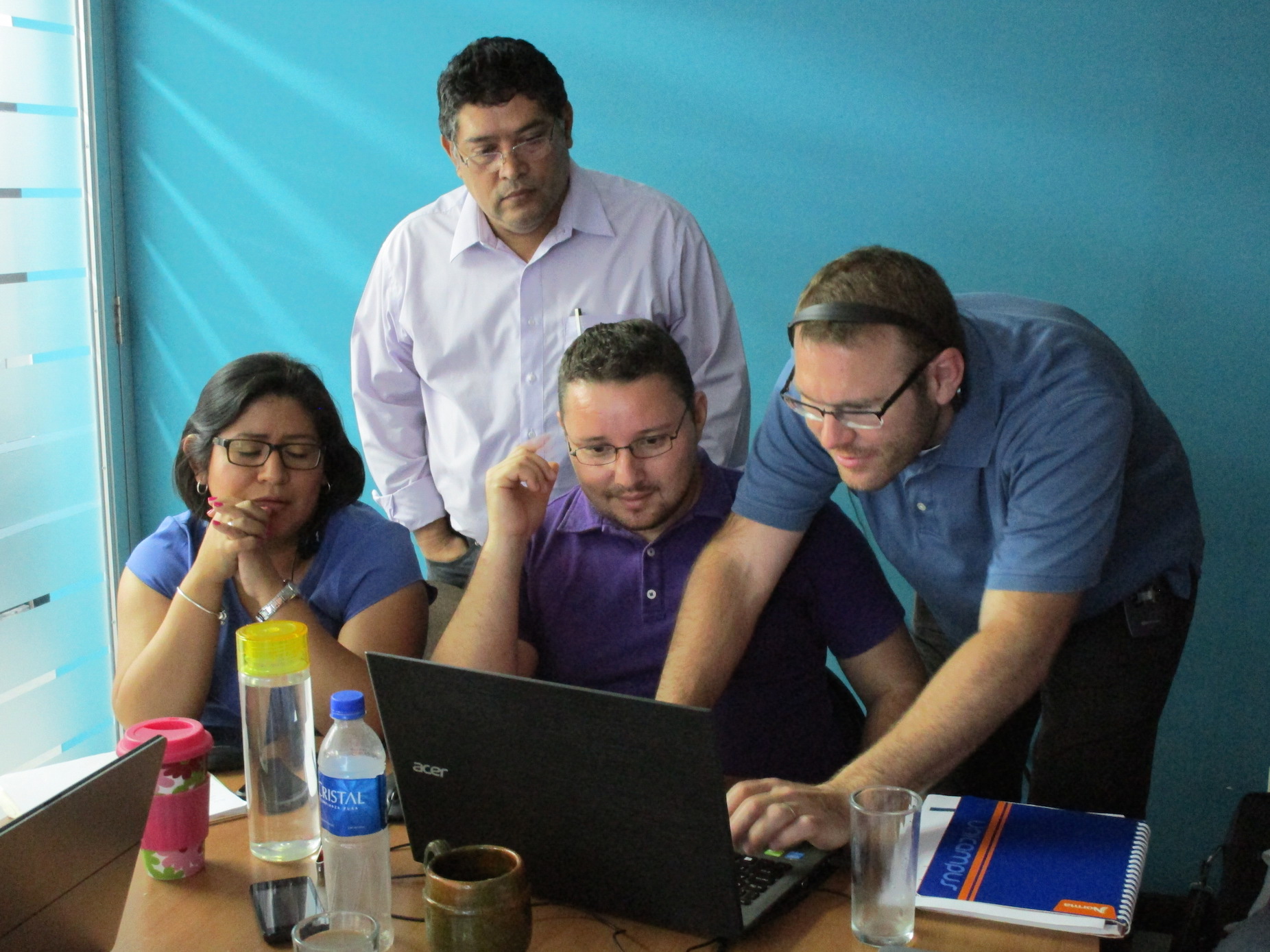NASA data helps Mesoamerican officials address air quality

Air quality is a public health concern in Mesoamerica. Estimates by the Pan American Health Organization concluded that more than 100 million people in Latin American cities are exposed to levels of air pollution that exceed recommended standards. Sunlight, weather, wildfires, wind-blown dust (sometimes transported hundreds of miles or even across the Atlantic Ocean), and emissions from human activities – especially in rapidly growing urban centers -- all affect air quality.
SERVIR Applied Sciences Team (AST) principal investigators Amy Huff from Pennsylvania State University and Amy Thomas from Battelle Memorial Institute, along with their team, also from Battelle, have been working since 2012 to provide decision-makers in Mesoamerica access to the data and tools they need to monitor air pollution and forecast air quality. The tools they have created will help these officials make decisions toward supporting emissions control measures and protecting public health.
For example, Huff’s and Thomas’s team has worked with the Ministry of Environment and Natural Resources (MARN) of El Salvador to develop a special website allowing visualization of high-resolution data on aerosol optical depth (AOD) -- a critical indicator of air quality -- along with true-color imagery. The data come from NASA’s Moderate Resolution Imaging Spectroradiometer (MODIS) onboard the Terra and Aqua satellites. The AOD data is a measure of the amount of light that aerosols* -- tiny solid and liquid particles from dust, volcanic ash, smoke from wildfires, and man-made pollution -- scatter and absorb in the atmosphere. Aerosols such as smoke and other particles, if inhaled, can harm humans, causing asthma, cancer, and respiratory distress, and exacerbating other major health issues.
MARN officials plan to use the website, and its AOD information, in several ways.
“This website will undoubtedly bring benefits in the areas of air quality and atmospheric pollution on topics such as air quality indices and forecasts for the metropolitan area of San Salvador,” says Pablo Ayala of MARN.
“It will also be important for monitoring acute respiratory diseases, as well as issues related to forest fires, climate and weather, and agriculture. For climate and weather, monitoring AOD shows the potential concentration of condensation nuclei, useful during the beginning and end of the rainy season. For agriculture, it will help with issues related to drought or periods of low rainfall, highly applicable in agro-industrial unions in sectors such as coffee, sugar cane, and family farming.”
Members of Huff’s and Thomas’s team have also customized a national air quality model for El Salvador, using the U.S. Environmental Protection Agency’s Community Multiscale Air Quality (CMAQ) model as the foundation. The air quality model has been transferred to MARN and incorporates outputs of MARN’s WRF (the Weather Research and Forecasting) meteorological model. MARN will use CMAQ as part of their regular weather and air quality forecasting operations once assessment of model performance has been completed.
 |
| Group photo with workshop facilitators Natasha Sadoff and Erica Zell of Battelle and Minister Lina Pohl of MARN (center) and all the outreach workshop participants |
“The central idea of this product is that it and the air quality forecast procedures for San Salvador will serve as alert triggers in cases of high concentrations exceeding current established standards, so that we can offer the population a concrete view of the state of air quality,” explains Ayala. “We will now have the necessary inputs to perform efficient monitoring and forecasting so that the population can be informed in a timely manner.”
The SERVIR AST/Battelle team and MARN organized two events recently to continue progress made toward providing decision-makers in Mesoamerica access to the information and tools they need for daily air quality forecasting and monitoring of air pollution. The Outreach and Communication Workshop: Air Quality, Climate Change, and Health in El Salvador was held in San Salvador on 21-22 June 2016. The Technical Training: Capacity Building for Air Quality Management using the CMAQ Model followed on 23-24 June.
The workshop brought together over 40 people from a diverse range of organizations, including the Ministries of the Environment and Natural Resources, Transportation, Economy, and Health; Legislative Assembly and Supreme Court; General Directorate for Civil Protection; universities; and other independent consultants. Conference presenters included experts from MARN, the Ministry of Health, U.S. Agency for International Development (USAID), and Battelle.
The purpose of the workshop event was three-fold:
- To raise awareness of the connections between air quality, climate change, and health and the holistic approaches needed to address them
- To increase the capacity of government officials, environmental group staff, and researchers in El Salvador to leverage NASA Earth Science resources developed through the SERVIR project
- To work collaboratively toward addressing risks and improving outreach and communication in air quality, climate change, and health
 |
| MARN’s Pablo Ayala, the workshop co-facilitator, oversees small groups as they discuss case studies |
Major topics included air quality and climate change, urban air pollution in El Salvador, health impacts of air pollution, national and international policies and strategies related to air quality and climate change, NASA satellite products and tools, and public participation and effective governance. Workshop discussions brought to the forefront important issues regarding a holistic and integrated approach to air quality, climate change, and health, and the tools, analysis, and best practices needed to address them in El Salvador.
When the participants were asked what they liked most about the event, most agreed that the most valuable take-away was the information about the various readily-available satellite tools -- including tools developed through this project and other tools such as NASA Worldview -- that will provide better information about air quality.. Below are some individual answers given by attendees asked whether they thought they would be able to use what they learned.
“Yes, because we must include it within regulatory reforms involving transportation. The knowledge will help inform an action plan to improve air quality.”
“Yes, because it can be applied to data about the content of sulfur and magnesium in fuels.”
“Yes I will be able to use it, because the satellite tools contain valuable information about parameters such as temperature, precipitation, atmospheric pollutants, socio-economic levels, and not only for our country but also for other countries in the region and in the world.”
“Of course it will. My work is creating an environment unit and I will be one of the technicians in charge. You have provided me with great air quality monitoring tools.”
“Yes. With my work in governmental matter I can share these initiatives with them which will hopefully help inform their decision for the good of our communities.”
The second SERVIR event of the week was the Technical Training on using the CMAQ modeling system. Nine MARN staff members from air quality, monitoring, and geospatial units attended the training, which covered air quality modeling, CMAQ hardware requirements, how to run the model, required inputs, components, model outputs, and more.
Thomas’s and Huff’s team will continue to work with MARN over the coming months to ensure that MARN is able to sustainably and accurately run CMAQ and incorporate it into their suite of air quality tools. Ultimately, MARN hopes to use CMAQ output to add forecasted warnings to air quality index (AQI) announcements, a significant step in more comprehensive air quality management in El Salvador. However, additional work must first be done. The model must be further developed and tested. For example, major industrial point sources and mobile sources (trucks, cars, etc.) of air pollution need to be added and the model needs to be evaluated using particulate matter (PM) ground-based monitoring data.
Huff’s and Thomas’s team, through SERVIR, are also working with the National Institute for Meteorology (IMN) in Costa Rica to develop a CMAQ model for similar air quality purposes in Costa Rica. It is anticipated that a regional air quality management network can be established and that El Salvador and Costa Rica can lead the effort to monitor, visualize, and forecast air quality in the region.
NOTES:
- *Aerosols can also affect the weather by reflecting and scattering sunlight back out into space and thus cooling the Earth’s surface. In addition, aerosol particles give water droplets something to cling to as the droplets form and gather in the air to make clouds.
- The AOD visualization website uses a Google Maps display with zoom-in and zoom-out capability and the option to download true color imagery (RGB) and AOD imagery for a selected zoom-in level as a PNG graphics file.
- Funding for the workshop and training was provided by the SERVIR AST through NASA. Significant in-kind contributions were provided by staff from MARN, who helped plan the outreach workshop, made several presentations to provide local context, and identified and invited the participants. MARN also provided the space for the technical training.


